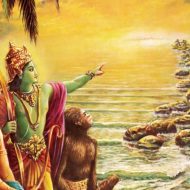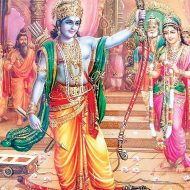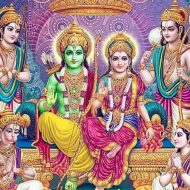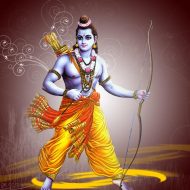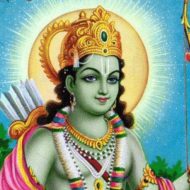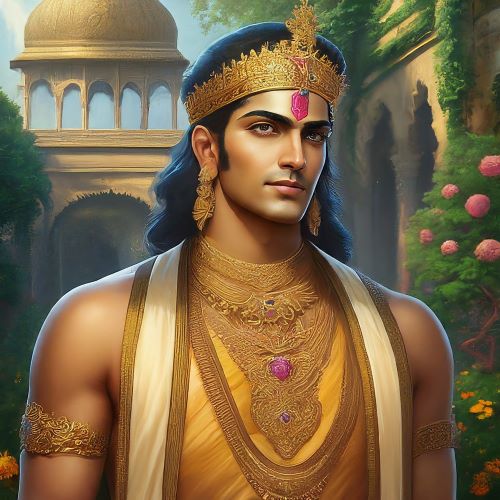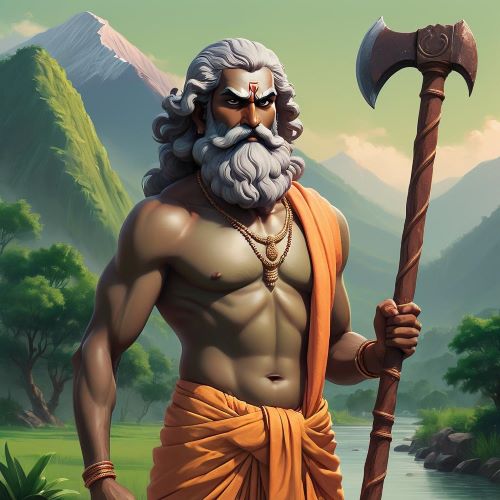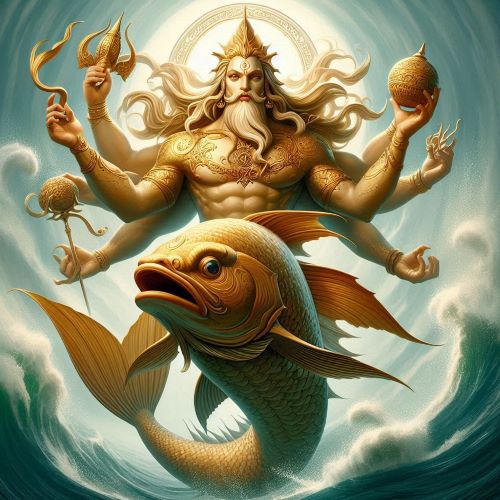Rama : The Ideal King of Dharma and Devotion
Listen
At a glance
| Description | |
|---|---|
| Origin | Indian Mythology |
| Classification | Demigods |
| Family Members | Dashratha (Father), Kausalya (Mother), Sita (Wife), Lakshmana (Brother), Bharatha (Brother), Shatrugnha (Brother), Luv (Son), Kush (Son) |
| Region | India |
| Associated With | Royalty, Virtue, Ethics, War |
Lord Rama
Introduction
Rama, the seventh incarnation of the god Vishnu, stands as one of the most revered figures in Indian mythology and literature. His life story, immortalized in the epic Ramayana by the sage Valmiki, defines ideals of morality, righteousness, and leadership. Often hailed as Maryada Purushottama — “the perfect man” — Rama embodies the balance between divine duty and human emotion.
Born to King Dasharatha and Queen Kausalya in Ayodhya, Rama’s life is not one of luxury but of trials that reveal his strength of character. His exile, the abduction of his wife Sita, and his epic battle with Ravana serve as lessons in dharma (righteousness), justice, and sacrifice. More than a hero, Rama is the model king whose life teaches the timeless values of restraint, compassion, and unwavering faith in the cosmic order.
Physical Traits
Rama is traditionally depicted as a handsome prince with blue or azure skin, symbolizing infinity, calmness, and divine depth. His broad shoulders, serene face, and unwavering gaze represent both his warrior spirit and saintly disposition. Dressed in royal attire with a bow (Kodanda) and quiver of arrows, he embodies readiness, discipline, and humility.
Many scriptures describe Rama’s beauty as unmatched — not for vanity but as a reflection of his inner harmony and virtue. His presence is said to bring peace to those around him. Even in battle, he remains composed, fighting without anger and ruling without ego. The physical depiction of Rama — poised, graceful, yet powerful — mirrors the Hindu concept of sattva (purity and balance).
Family
Rama’s lineage and family relationships are central to his story. He is the eldest of four brothers — Bharata, Lakshmana, and Shatrughna — all born to King Dasharatha’s different queens. His bond with Lakshmana is particularly strong; Lakshmana accompanies him throughout his 14-year exile, symbolizing brotherly devotion and service.
Rama’s wife, Sita, is regarded as the ideal woman — pure, loyal, and courageous. Their union represents the perfect partnership between virtue and compassion. Their sons, Lava and Kusha, later become legendary rulers and poets, continuing the moral and literary legacy of the Ramayana.
Even the antagonistic relationships in Rama’s life carry symbolic meaning. His confrontation with Ravana, the ten-headed king of Lanka, is not just a war between good and evil but between discipline and desire, dharma and arrogance. Rama’s ability to show compassion even to Ravana at the end of the battle reveals his divine forbearance.
Other Names
Rama is known by many names across traditions and cultures. As Maryada Purushottama, he is the embodiment of perfect virtue. In the Ramcharitmanas by Tulsidas, he is called Raghunatha or Raghava, meaning “descendant of Raghu,” his royal lineage. Devotees in southern India often refer to him as Sri Ramachandra, emphasizing his connection with divinity and the moon (Chandra).
In Jain and Buddhist retellings, Rama appears as a virtuous prince upholding truth and peace without violence. Across Southeast Asia — from Indonesia’s Ramakien to Cambodia’s Reamker — his name and story have been adapted to local cultures, yet the central idea of Rama as the ideal ruler remains unchanged.
Powers and Abilities
As an avatar of Vishnu, Rama possesses both divine and human traits. His abilities are extraordinary but always used with restraint — a reflection of moral power over brute force. He is a master archer whose skill with the bow symbolizes his control over the senses. Legends speak of his ability to defeat entire armies and celestial beings through focus and righteousness rather than aggression.
Rama’s true strength lies in his unwavering commitment to dharma. Even when faced with personal suffering — such as his exile or separation from Sita — he prioritizes duty over emotion. His leadership radiates justice and humility; he listens before acting and forgives even when wronged.
In spiritual terms, Rama’s power is transformative — he uplifts everyone he encounters. Saints and poets often interpret him as the personification of the cosmic balance where divine will, human morality, and social order align perfectly.
Modern Day Influence
Rama’s influence extends beyond scripture into daily life, politics, and art. His story is retold in countless plays, films, and television series, most famously in Ramanand Sagar’s Ramayana, which brought his legend to millions across India. Festivals like Rama Navami celebrate his birth, while Dussehra marks his victory over Ravana as a triumph of good over evil.
Philosophically, Rama represents leadership grounded in ethics — a figure often cited as the model for governance and integrity. The term Rama Rajya (“the rule of Rama”) has entered political discourse as the symbol of an ideal state built on justice, equality, and compassion.
Globally, Rama’s image transcends religion. Artists and writers from Southeast Asia, Europe, and beyond have drawn inspiration from his virtues and dilemmas. In Thailand, Indonesia, and Cambodia, adaptations of the Ramayana feature Rama as a cultural hero rather than a deity, showing his universal appeal as the embodiment of righteous rule.
In the modern world, Rama’s relevance endures as people seek balance between spiritual duty and social responsibility. His story invites reflection on leadership, love, and morality — themes that continue to define humanity’s quest for harmony.
Related Images
Source
Goldman, R. P. (1984). The Ramayana of Valmiki: An Epic of Ancient India, Volume I: Bala-Kanda. Princeton University Press.
Doniger, W. (2009). The Hindus: An Alternative History. Penguin Press.
Tulsidas. (1574). Ramcharitmanas. Translated by R. N. Singh, Motilal Banarsidass.
Narayan, R. K. (1972). The Ramayana: A Shortened Modern Prose Version of the Indian Epic. Penguin Classics.
Brockington, J. L. (1998). The Sanskrit Epics. Brill Academic Publishers.
Bryant, E. F. (2003). Krishna: A Sourcebook. Oxford University Press.
Klostermaier, K. K. (2007). A Survey of Hinduism. State University of New York Press.
Wikipedia contributors. (n.d.). Rama. In Wikipedia, The Free Encyclopedia. https://en.wikipedia.org/wiki/Rama
Frequently Asked Questions
What is Rama the god of?
Rama is not technically a god in the traditional sense, but rather an avatar of Vishnu, who is one of the most important gods in Hinduism. Vishnu is often considered the supreme god, responsible for preserving and protecting the universe. As an avatar, Rama represents a specific incarnation of Vishnu on Earth. He is considered the seventh avatar and is revered for his righteousness, piety, and devotion to duty.
How many died in Ramayana war?
The exact number of casualties in the Ramayana war remains unknown. Varying estimates exist, ranging from 100,000 to 1.6 million, depending on interpretations of descriptions within the text and the size of the armies involved. While the precise figure remains elusive, the Ramayana war undoubtedly caused significant loss of life, making it a major and impactful event in Hindu mythology.
How is Rama born?
Rama’s birth is a divine event signifying the descent of a god onto Earth. While exact details vary, the core narrative involves a religious ritual, auspicious timing, miraculous occurrences, and multiple mothers playing a role. Ultimately, his birth symbolizes the triumph of good over evil and the restoration of order and righteousness.
How did Sri Rama died?
Sri Rama’s departure from the earthly realm is not a traditional death but an ascension to his divine source. He enters a deep meditative state (Yoga Nidra) or performs a water ritual (Jal Samadhi), symbolizing his merging with the divine and leaving his physical form behind. This signifies the impermanence of the earthly world and the eternal nature of the divine. Interpretations may vary, but the core message remains consistent: Sri Rama’s journey and ascension represent the triumph of good and his ultimate return to the divine.
How long did Rama live?
Determining Rama’s lifespan is complex, as the Ramayana offers different perspectives. Some interpret it literally, suggesting a 11,000-year life based on the text’s descriptions. Others view it symbolically, suggesting a lifespan closer to that of an average human. Ultimately, the exact duration remains open to interpretation and individual understanding.




